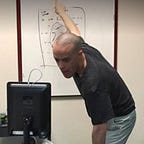The night we drove to every school bus stop in Freetown
This past summer, Unicef Innovation and Unicef Sierra Leone agreed to let me work on site with the Directorate of Science, Technology, and Innovation (DSTI) in Freetown. DSTI sits in the Office of the President. You can read about it here.
The mission was to collaborate with DSTI staff on open source technology for data driven decision making in Education policy. We did a lot of cool things, and I’ll write about them later. This article is about the night we drove to every single school bus stop in Freetown.
As the new school year was approaching, routes for a batch of new school buses, recently allotted to Freetown, needed planning. While we were able to obtain a list of the names of all the school bus stops throughout the city, we couldn’t find a map. We thought that one contribution we could make would be to create that map and give it to the Freetown City Council.
On this endeavor was Kumba Musa (data scientist), Ibrahim Bayoh (software developer), and myself. The first thing we did was ask one of DSTI’s experienced drivers to look at the list, and point out each location on a map.
The driver’s name was Abubakar Kebbie. He is tasked each day with transporting the international interns and visiting engineers from the DSTI residence to State House and back. If you’ve ever been to Freetown, you’ll know that it’s full of steep hills, seemingly stacked upon each other. Many of the roads are still unpaved, and can be very rough to drive, especially during the rainy season. Abubakar is one of the few people I have full confidence in as his passenger in Freetown.
Abubakar responded that, while he knew the location of each stop, it was impossible to mark them on a map without any aids.
That didn’t make sense to me at the time, but then, I didn’t know Freetown very well. Ultimately, we decided to visit each stop on the list and take geo-coordinates. That decision was made at around 4:30 PM and we agreed to meet at 9 PM, long after rush hour. Abubakar picked me up at a small Indian restaurant at Hill Station at 9pm sharp. We drove to pick up Kumba at her home, and then Bayoh at his.
From there, we drove to Baw-Baw Beach Bus Stop, the first bus stop on the southern end of Peninsular Road in the Western Area Rural region. Bayoh and I took our first geo-coordinates on separate devices at 10:08pm. I used what3words to record my coordinates, I don’t know what Bayoh used to take his.
Once I geo-located our position, I used the share option on the what3words app to send it to the “DSTI Data Science 4 Education” whatsapp group we had created a month earlier. In retrospect, it may have been a better idea to use twitter.
Six hours, or 89 stops later, we ended at Aberdeen Road Junction at 3:59AM. Abubakar had driven us to every bus stop but one, the stop in Regent, which we would fetch the following day.
The next day, we all rolled in to work at around noon. We began by comparing the two lists of coordinates, compiling CSVs, and correcting the bus stop names I’d mangled throughout the previous night as Kumba read them outload at each stop.
To make the map more useful, we added the school locations, colored them by distance to nearest bus stop, and set each radius to the size representative of their enrollment.
Credits & acknowledgements
- The distance to nearest bus stop was calculated using Adam Rahman’s magicbox-site-routing library.
- Big thank you to OSM-Sierra Leone & Youth Mappers for offering to help. We learned about you too late but will request your help during our next mapping project.
